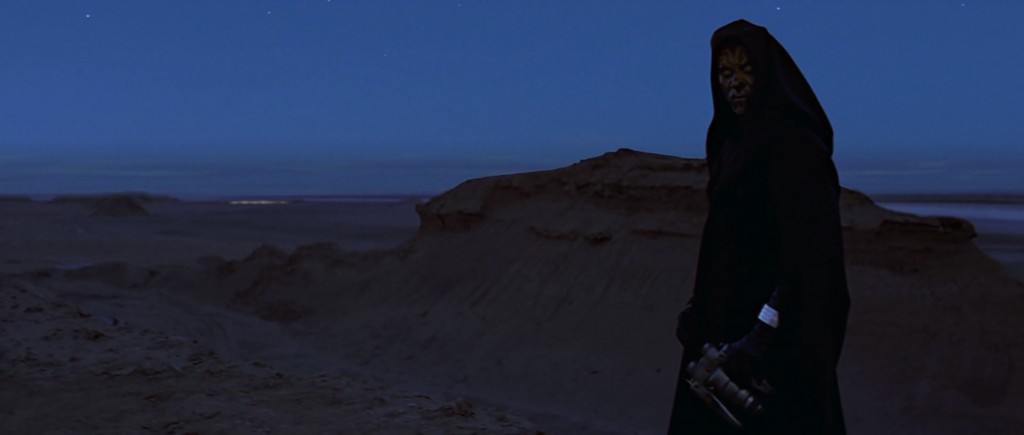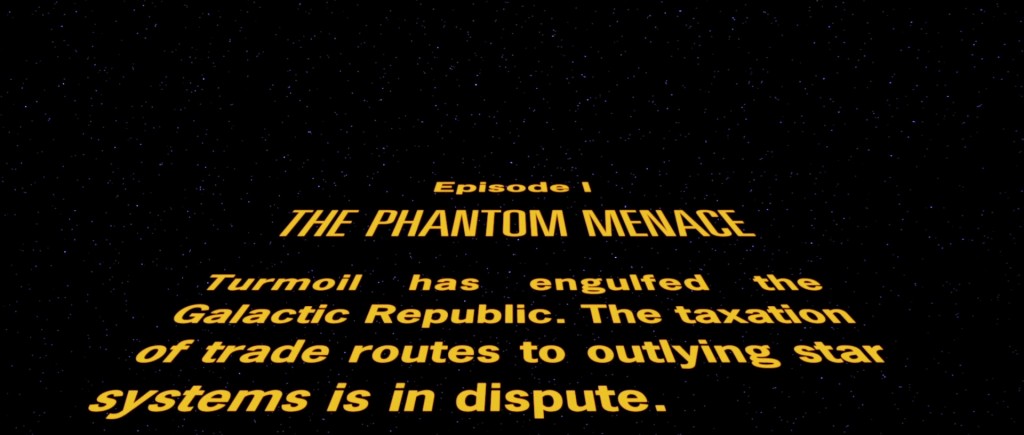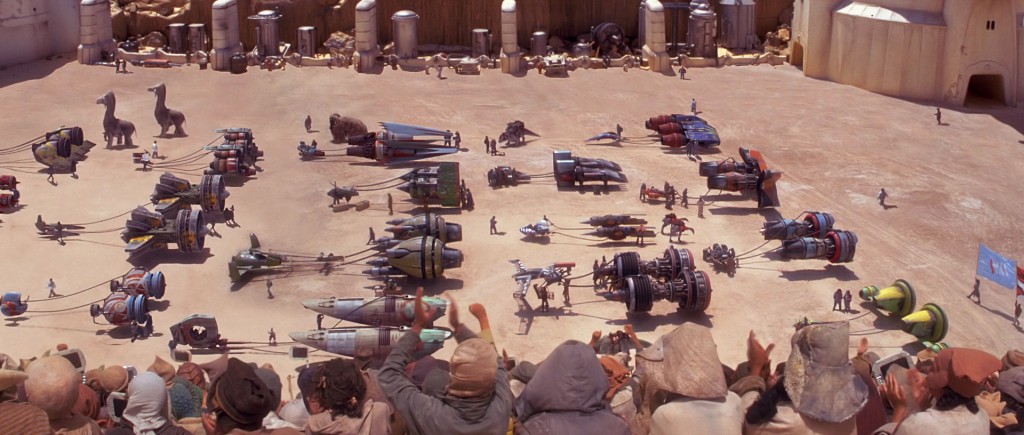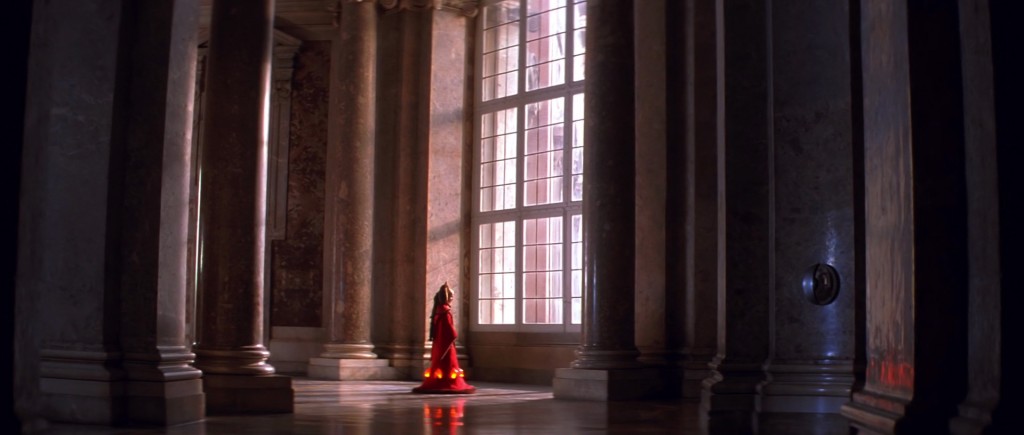Star Wars Episode I: The Phantom Menace has remained one of the most reviled films in modern cinema since its release in 1999. It’s easy to understand why; Episode I was easily the most anticipated motion picture ever at the time, and was such a crushing disappointment that it’s still a bitter subject for thousands of fans. Star Wars devotees seem to agree overwhelmingly that the film should never have been made, but in a sense, it’s sort of miraculous that a movie like this ever did get made. Not because it’s surprising that George Lucas could acquire $115 million to produce a Star Wars prequel (even being a critical disaster, it’s still grossed over $1 billion), but because the script to The Phantom Menace is so bizarre that there’s no way in hell it would have been produced if the words Star Wars weren’t also in the title.
Imagine that The Phantom Menace was released not as the long-awaited prequel to a beloved film franchise, but as its own movie, the beginning of a new sci-fi saga from a filmmaker you’d never heard of. Disregard the common settings and characters from the Star Wars universe, and consider the experience of seeing this movie in the theaters on a whim, or catching it on cable or Netflix years later, with no prior knowledge of the story or the world in which it takes place. While you’d likely find a lot of the same things irritating—Jar-Jar and Anakin are both still grating as hell, nothing to be done about that—odds are, your first response would be “damn, what a weird movie.”
The Phantom Menace follows Qui-Gon Jinn (Liam Neeson), a member of an order of mystic knights called the Jedi, on a journey across a galactic Republic that spans hundreds of planets and species. Jinn and his apprentice Obi-Wan Kenobi (Ewan McGreggor) are dispatched to settle a simple trade dispute on the planet Naboo, which escalates into an all-out occupation by the greedy Trade Federation and their robotic army. With off-world communications cut off, Jinn and Kenobi secret away the young Queen Amidala (Natalie Portman/Keira Knightley, it’s complicated) to the Republic’s capitol in the hopes of government intervention. Along the way, they encounter a slave boy (Jake Lloyd) who could fulfill an ancient Jedi prophecy, a deadly assassin (Ray Park), and the cunning Senator who’s secretly behind it all (Ian McDiarmid).
Just from that summary, let’s break down some of the components of this film. The plot to The Phantom Menace includes:
- Mystic space knights
- Trade disputes
- A teenage queen played by two people
- Government conspiracy
- Child slavery
The story is more complex even than most Hollywood films intended for adults, let alone a movie ostensibly aimed at children. Were this screenplay purchased by a studio rather than produced and directed by the screenwriter, it would likely have emerged from the studio notes and revision process a completely different, much simpler story. As a result, The Phantom Menace just plain feels different from just about anything else out there—it’s sort of a $100 million auteur film, one whose auteur is more wealthy than talented.
That being said, George Lucas certainly put his company’s wealth to good use; apart from the script and direction for which Lucas is primarily responsible, many of the other components of The Phantom Menace are remarkable. The production design alone is enough to set The Phantom Menace apart from its non-Star Wars contemporaries, with memorable costumes, awesome spaceships, and an excellent mix of practical and computer-driven creatures. Stunt Coordinator Nick Gillard’s choreography of the final battle between Qui-Gon Jinn, Obi-Wan Kenobi, and Darth Maul still holds up as a gorgeous ballet of martial arts, and John Williams’ original score may be the best of the entire Star Wars saga. It’s only the screenplay, acting, and cinematography that don’t work, and admittedly, that’s most of what makes a movie.
It’s easy to imagine that The Phantom Menace could have been a better movie if it hadn’t been a part of the Star Wars franchise. (True, it’s not hard to imagine The Phantom Menace being a better movie under any number of circumstances.) While the presence of irritating, unfunny comic relief character Jar-Jar Binks probably takes the cake for most unforgivable misstep in the story of Episode I, what really derails the movie is the inclusion of young Anakin Skywalker. The ensemble’s pit-stop on Tatooine in between escaping occupied Naboo and arriving at the capitol planet Coruscant takes nearly an hour, and serves no purpose in the larger story of this movie other than picking up Anakin, who could be easily excised from the rest of the movie with little impact. (Did we really need the little kid to blow up the Not-Death Star?) But it’s the presence of Anakin—and the Star Wars name, of course—that sells the movie, the promise that the prequel films would tell the origin story of Darth Vader, American cinema’s favorite villain.
This is the movie’s fatal flaw: Anakin has no business being in the story at all, and the role he does play stretches all suspension of disbelief to its breaking point. Eight-year-old Anakin Skywalker and his mother Shmi are slaves (why?) belonging to the junk dealer/gambler Watto, who has something Qui-Gon and co. need. Through a convoluted series of circumstances, Qui-Gon enters into a bet not only for the needed supplies, but also for Anakin’s freedom, since Anakin may be the Jedi messiah. Anakin has no father (again, why?), but he and his mother do have a spacious apartment and a patched-together droid helper, because apparently being a slave on Tatooine still gets you a more comfortable life than working 40 hours a week at Wal-Mart. Qui-Gon wins the bet and Anakin is free to leave the planet and become a Jedi, leaving his mother behind (and out of the way of the story). Anakin basically just tags along for the rest of the film so that he can show up in later installments. This is nearly half the movie and serves no purpose in this film.
Could it be that being a Star Wars movie and needing to set up two/five future films is what holds back The Phantom Menace from fulfilling its potential as a Dune-esque bizarre sci-fi opus? If it were an adventure story about a young queen uniting her planet against an invasion, about a secret plot to seize power in the Senate, about an ancient evil resurfacing to battle heroic peacekeepers, with Anakin cut out and the Jedi called by another name (and minus the proprietary lightsabers), would The Phantom Menace be salvageable, worthy of the cult status of ambitious box-office failures like The Chronicles of Riddick?
It’s common in today’s Hollywood for a film to face the double-edged lightsaber of an established franchise. While having Spider-Man or Halloween in the title gives a film immediate attention, it also faces the harsher scrutiny of being directly compared to a movie that the audience already likes. Rarely does a sequel, a remake, or a reboot compare favorably to the original among the old guard of fans. In some cases, a story is better off standing alone, to be judged on its own merits.
That being said, The Phantom Menace is still terrible.






Couldn’t agree more, Dylan. Recently rewatched this movie after many years away from it, and I was really struck by just how much it has to try to do. The plot is remarkably convoluted and ambitious with what it tries to establish; even within the Star Wars universe it is difficult to keep straight just what, exactly, is happening and why. That’s exacerbated by the fact that the pacing rushes the audience from plot point to plot point too fast for the importance of each detail to sink in and stick–whether you’re a Star Wars devotee or a novice doesn’t seem to impact that fact.